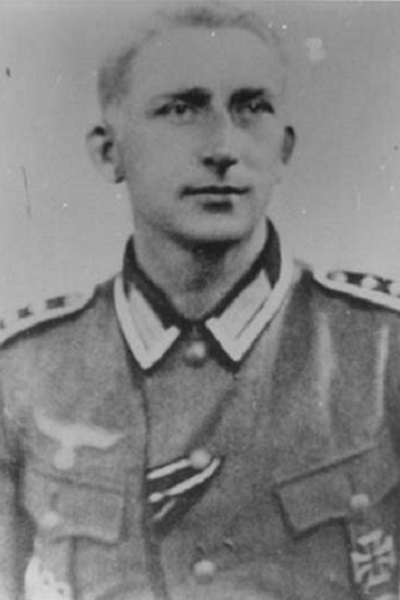Schaten, Heinrich
- Date of birth:
- April 10th, 1915 (Heek/Westphalia, Germany)
- Date of death:
- December 21st, 1996 (Hasternath/North Rhine-Westphalia, Germany)
- Nationality:
- German
Biography
Do you have more information about this person? Inform us!
- Period:
- Second World War (1939-1945)
- Rank:
- Oberfeldwebel (Warrant Officer)
- Unit:
- Zugführer, 6. Kompanie, II. Bataillon, Grenadier-Regiment 1, 1. Infanterie-Division, Heer
- Awarded on:
- May 9th, 1945
“The II./Grenadier-Regiment 1 was ordered to relocate from Salten to Kussen in the early morning hours of the 17.01.1945. Upon arriving at Kussen they were to remain there as a divisional reserve.
Oberfeldwebel Schaten’s 6. Kompanie was in the lead, and it was the first Kompanie of the Bataillon to reach Kussen. However, before it entered the village itself, 6. Kompanie received sudden and unexpectedly heavy MG and mortar fire from the northern edge of Kussen. It was only later that situation reports revealed that the enemy had pivoted north and occupied the village following a successful penetration of our lines far to the south of Kussen (see map).
Despite the enemy’s surprise, Oberfeldwebel Schaten was able to immediately determine the overall consequences of their actions for the wider combat situation. He knew that friendly forces still had to be occupying the section of the Rominte Position east of Kussen, which in turn meant that the enemy occupation of Kussen created a great danger for these friendly forces.
Oberfeldwebel Schaten immediately deployed his Kompanie from the march and launched an attack on his own initiative despite the lack of fire support from artillery or heavy weapons. The enemy had all the advantages of this battle, having both abundant heavy weapons and favourable terrain in which to fight. Even so, Oberfeldwebel Schaten’s Kompanie had the advantage of a commander who’s incredible attacking spirit inspired his men to go forwards against the odds. Ultimately, and in spite of the great disparity of forces, the Kompanie managed to eject the reinforced Bolshevik battalion that had established itself in Kussen. 87 enemy dead were counted afterwards, and the captured enemy materiel included 3 heavy machine-guns, 4 light machine-guns, 1 anti-tank gun and numerous small arms and valuable equipment.
However the enemy were not prepared to relinquish their control of the village. Oberfeldwebel Schaten’s Kompanie ended up repulsing 3 enemy counterattacks in order to hold the line long enough for the remainder of II. Bataillon to arrive and consolidate the position.
Oberfeldwebel Schaten’s decision to take up the fight against a significantly stronger Bolshevik unit was a phenomenal demonstration of initiative and bravery. Here it was his actions alone that protected the rear area of those friendly forces still fighting in the Rominte Position. He mastered this almost hopeless situation through a combination of ruthlessness, independent leadership and a magnificent offensive spirit. His achievement here was what enabled the construction of a coherent frontline in this area.”
To this was added a further endorsement by the commander of the 1. Infanterie-Division…
“An experienced, distinguished and decisive Zugführer. Oberfeldwebel Schaten’s independently conducted attack and subsequent fearless defence against 3 strong enemy attacks was a critical development for the entire Division.
Due to the strong enemy armoured breakthrough against the Division’s right wing and the right neighbour, Kussen was of crucial importance for the continued holding of the Rominte Position.
He clearly deserves recognition through the award of the Knight’s Cross to the Iron Cross.”
His nomination was submitted to the Heerespersonalamt (HPA—Army Staff Office) on 19-4-1945. The book of "Verliehene Ritterkreuze" (Awarded Knight Crosses) contains an entry under Nr. 5176 stating the entry date 19-4-1945 and Major Joachim Domaschk approval "Knight's Cross yes". The file contains no further evidence of the approval or presentation of the award. The registry containing the approved or rejected nominations or deferred nominations contains his file card. According to the Association of Knight's Cross Recipients (OdR) the award was presented in accordance with the Dönitz-decree. This is illegal according to the Deutsche Dienststelle (WASt) and lacks legal justification. The presentation date was assigned by Walther-Peer Fellgiebel.
- Period:
- Second World War (1939-1945)
- Awarded on:
- September 19th, 1944
- Period:
- Second World War (1939-1945)
- Rank:
- Oberfeldwebel (Warrant Officer)
- Unit:
- 6. Kompanie, II. Bataillon, Grenadier-Regiment 1, 1. Infanterie-Division, Heer
- Awarded on:
- September 14th, 1943
According to other source the awarding date is 15-9-1943.
- Period:
- Second World War (1939-1945)
- Awarded on:
- June 29th, 1943
- Period:
- Second World War (1939-1945)
- Awarded on:
- January 19th, 1943
- Period:
- Second World War (1939-1945)
- Awarded on:
- October 15th, 1942
- Period:
- Second World War (1939-1945)
- Awarded on:
- May 18th, 1942
- Period:
- Second World War (1939-1945)
- Awarded on:
- September 13th, 1941
- Period:
- Second World War (1939-1945)
- Awarded on:
- October 13th, 1939












